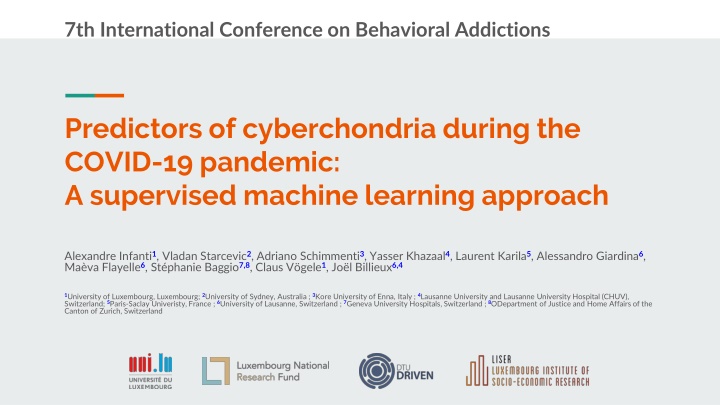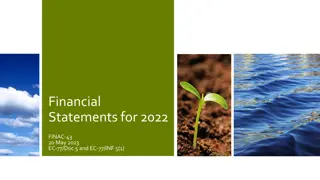
Predictors of Cyberchondria During COVID-19 Pandemic
Explore the impact of COVID-19 on cyberchondria levels and psychological predictors using supervised machine learning. The study investigates the occurrence of compulsive online health information searches and associated factors during the pandemic, shedding light on the influence of threat perception, uncertainty, and online health seeking behavior. French speakers from Switzerland, France, Belgium, and other countries participated in the research, providing valuable insights into cyberchondria severity and related psychological measures.
Download Presentation

Please find below an Image/Link to download the presentation.
The content on the website is provided AS IS for your information and personal use only. It may not be sold, licensed, or shared on other websites without obtaining consent from the author. If you encounter any issues during the download, it is possible that the publisher has removed the file from their server.
You are allowed to download the files provided on this website for personal or commercial use, subject to the condition that they are used lawfully. All files are the property of their respective owners.
The content on the website is provided AS IS for your information and personal use only. It may not be sold, licensed, or shared on other websites without obtaining consent from the author.
E N D
Presentation Transcript
7th International Conference on Behavioral Addictions Predictors of cyberchondria during the COVID-19 pandemic: A supervised machine learning approach Alexandre Infanti1, Vladan Starcevic2, Adriano Schimmenti3, Yasser Khazaal4, Laurent Karila5, Alessandro Giardina6, Ma va Flayelle6, St phanie Baggio7,8, Claus V gele1, Jo l Billieux6,4 1University of Luxembourg, Luxembourg; 2University of Sydney, Australia ; 3Kore University of Enna, Italy ; 4Lausanne University and Lausanne University Hospital (CHUV), Switzerland;5Paris-Saclay Univeristy, France ; 6University of Lausanne, Switzerland ; 7Geneva University Hospitals, Switzerland ; 8ODepartment of Justice and Home Affairs of the Canton of Zurich, Switzerland
INTRODUCTION Cyberchondria = Compulsive searches for online health information Lack of control, health anxiety, interference, distress Associated with: (a) health anxiety (b) problematic internet use (c) obsessive compulsive symptoms (Arsenakis et al., 2021; Starcevic et al., 2019)
INTRODUCTION COVID-19 context (Starcevic et al., 2021) May contribute to the occurrence or exacerbation: (a) Perception of threat + poorly understood (b) Uncertainty undermines attempts to cope with the situation (c) Lack of evidence-based health information coping efforts fail (d) Conflicting, unverified and constantly updated Confusion (e) Online health information seeking information ; reassurance fear ++ ; distress ++
AIMS Investigate levels of cyberchondria during vs before the pandemic Identify the psychological factors that predict cyberchondria during the pandemic
METHOD Participants French speakers Country of residence: Switzerland (8.8%) France (66.1%) Belgium (6.2%) Other (18.9%) N = 725 ( = 57.4%) 18 - 77 y.o (M = 33.29, SD = 12.88)
METHOD Measures Potential predictor variables based on the psychological model of cyberchondria during COVID-19 (Starcevic et al., 2021) Cyberchondria Severity Scale Short Form (CSS-12) before ( retrospective)and during COVID-19 Multidimensional Assessment of COVID-19-Related Fears (MAC-RF) Intolerance of Uncertainty Scale-Short Form (IUS-SH) Patient Health Questionnaire (PHQ-15) Short Health Anxiety Inventory (SHAI)
METHOD Measures + 2 potentially relevant: diminished control + interpersonal difficulties (Vismara et al., 2020) Relationship Questionnaire (QR) Short UPPS-P Impulsive Behavior Scale (s-UPPS-P)
METHOD Data analysis Aim 1 : Does cyberchondria increased during the pandemic in comparison with a retrospectively assessed cyberchondria ? non normal distribution Comparison Before et During COVID-19: Wilcoxon signed ranks test for dependent samples + Effect of gender (during COVID-19) Mann-Whitney U test Effect of age and education (during COVID-19) Kruskal-Wallis tests
METHOD Data analysis Aim 2 : Determine the factors that predict cyberchondria during the pandemic Non normal distribution DV = CSS-12 subscales most impacted by the pandemic (aim 1) Selection of predictors : Spearman correlations matrix Threshold for selection: .30 (moderate effect size: Cohen, 1988; Maher et al., 2013) Regressions (machine learning) Model = Elastic Net Method = Nested cross validation
METHOD Nested cross validation
METHOD Reported measures R mean (4x25 runs) with SD Adjusted R : (Yin et Fan, 2001)
RESULTS - Aim 1 CSS-12 scores before vs. during COVID-19 M (SD) score before COVID-19 M (SD) score during COVID-19 Mdn Mdn score before COVID-19 score during COVID-19 Z p value Effect size Total score 26.68 (8.04) 26.64 (8.88) 26 26 -0.150 .880 0.006 Excessiveness (subscale) 9.36 (2.85) 9.26 (3.06) 9 9 -0.763 .446 0.028 Distress (subscale) 6.67 (2.88) 6.83 (3.12) 6 6 -3.651 <.001 0.136 Reassurance (subscale) 5.90 (2.32) 5.54 (2.48) 6 5 -6.680 <.001 0.248 Compulsion (subscale) 4.75 (2.24) 5.00 (2.51) 5 4 -5.697 <.001 0.212
RESULTS - Aim 1 Gender, age and education effects on the CSS-12 scores (during COVID-19) CSS-12 Total score Excessiveness (subscale) Distress (subscale) Reassurance (subscale) Compulsion (subscale) Effect Test Groups N Mdn Test result Mdn Test result Mdn Test result Mdn Test result Mdn Test result Gender Mann- Whitney U Women Men 416 302 26 26 Z = - .413 p = .680 9 9 Z = -.013 p = .989 7 6 Z = -1.362 p = .173 5 5 Z = -1.075 p = .282 4 4 Z = -1.567 p = .117 Age Kruskal- Wallis H 15-24 25-34 35-44 45-54 55 and + 248 204 117 91 65 28 26 26 22 25 H(4) = 22.941 p < .001 10 10 9 8 9 H(4) = 31.993 p < .001 7 H(4) = 20.168 p <.001 5 5 5 4 5 H(4) = 7.001 p = .136 4 4 4 3 3 H(4) = 6.768 p = .149 6.5 6 6 6 Education Kruskal- Wallis H Lower sec. Upper sec. Bachelor Master PhD 23 102 308 236 56 25 25 26 26 22 H(4) = 10.825 p = .029 8 9 9 10 8 H(4) = 11.838 p = .019 6 6 7 7 5 H(4) = 15.115 p = .004 4 5 5 5 4 H(4) = 12.366 p = .015 4 4 4 4 4 H(4) = 2.597 p = .627
RESULTS - Aim 2 Spearman correlations matrix Reassurance (subscale) correlations .30 Distress (subscale): COVID-19-related fears (r = .515; p <.01) Health anxiety (r = .491; p <.01) Intolerance of uncertainty (r = .315; p <.01) Compulsion (subscale) COVID-19-related fears (r = .348; p <.01) Health anxiety (r = .355; p < .01)
RESULTS - Aim 2 Elastic Net regressions (nested cross validation) n.b. during COVID-19 COVID-19- related fears coef. (SD) Health anxiety coef. (SD) Intolerance of uncertainty coef. (SD) Dependent variable R (SD) Adjusted R (SD) [95% CI] RMSE (SD) MAE (SD) Distress (subscale) 0.344 (0.059) 0.333 (0.06) [0.321, 0.345] 2.512 (0.109) 2.003 (0.09) 1.018 (0.073) 0.938 (0.075) 0.158 (0.088) Compulsion (subscale) 0.152 (0.046) 0.143 (0.047) [0.133, 0.152] 2.294 (0.14) 1.776 (0.092) 0.609 (0.054) 0.505 (0.055) Variable not incorporated in the predictive model
DISCUSSION CSS-12 subscales : Distress , Compulsion , Reassurance Excessive online health searches do not provide reassurance Searches became more distressing and cause impairment CSS-12 total score : did not change during the pandemic May not reflect relevant/meaningful alterations in the patterns Should use the CSS-12 subscales in addition to total CSS-12 score
DISCUSSION Confirms results of numerous studies - significant relationship between cyberchondria and: Health anxiety (Arsenakis et al., 2021; Fergus & Spada, 2018; McElroy et al., 2019; McMullan et al., 2019; Starcevic et al., 2019) COVID-19-related fears (Jungmann & Witth ft, 2020; Oniszczenko, 2021; Seyed Hashemi et al., 2020; Wu et al., 2021) Impulsivity traits Weak correlations ( <.11) Cyberchondria = better conceptualized as a behavior characterized by compulsivity and/or reassurance seeking rather than impulsivity (Starcevic, Berle, & Arn ez, 2020 ; Vismara et al., 2020)
LIMITATIONS Self-report instruments biais Cross-sectional causal relationships Self-selected nature of the sample general population Retrospective assessment of pre-pandemic levels of cyberchondria
CONCLUSION Distress and Compulsion : Increase during the COVID-19 pandemic Strongly predicted by COVID-19-related fears and health anxiety Support theoretical model of cyberchondria during the COVID-19 pandemic (Starcevic et al., 2021) Cyberchondria as a multi-dimensional construct and its assessment Need to be re-examined Cyberchondria is a public health issue of particular relevance during health crises such as pandemics (Starcevic et al., 2021 ; Varma et al., 2021)
SOURCES Arsenakis, S., Chatton, A., Penzenstadler, L., Billieux, J., Berle, D., Starcevic, V., Viswasam, K., & Khazaal, Y. (2021). Unveiling the relationships between cyberchondria and psychopathological symptoms. Journal of Psychiatric Research, 143, 254-261. https://doi.org/10.1016/j.jpsychires.2021.09.014 Cohen, J. (1988). Statistical power analysis for the behavioral sciences (2nded.). Routledge. https://doi.org/10.4324/9780203771587 Fergus, T. A., & Spada, M. M. (2018). Moving toward a metacognitive conceptualization of cyberchondria: Examining the contribution of metacognitive beliefs, beliefs about rituals, and stop signals. Journal of Anxiety Disorders, 60, 11-19. https://doi.org/10.1016/j.janxdis.2018.09.003 Jungmann, S. M., & Witth ft, M. (2020). Health anxiety, cyberchondria, and coping in the current COVID-19 pandemic: Which factors are related to coronavirus anxiety? Journal of Anxiety Disorders, 73, 102239. https://doi.org/10.1016/j.janxdis.2020.102239 Maher, J. M., Markey, J. C., & Ebert-May, D. (2013). The other half of the story: Effect size analysis in quantitative research. CBE Life Sciences Education, 12(3), 345-351. https://doi.org/10.1187/cbe.13-04-0082 McElroy, E., Kearney, M., Touhey, J., Evans, J., Cooke, Y., & Shevlin, M. (2019). The CSS-12: Development and validation of a short-form version of the cyberchondria severity scale. Cyberpsychology, Behavior, and Social Networking, 22(5), 330-335.https://doi.org/10.1089/cyber.2018.0624 McMullan, R. D., Berle, D., Arn ez, S., & Starcevic, V. (2019). The relationships between health anxiety, online health information seeking, and cyberchondria: Systematic review and meta-analysis. Journal of Affective Disorders, 245, 270-278. https://doi.org/10.1016/j.jad.2018.11.037 Oniszczenko, W. (2021). Anxious temperament and cyberchondria as mediated by fear of COVID-19 infection: A cross-sectional study. PLOS ONE, 16(8), e0255750. https://doi.org/10.1371/journal.pone.0255750
SOURCES Seyed Hashemi, S. G., Hosseinnezhad, S., Dini, S., Griffiths, M. D., Lin, C.-Y., & Pakpour, A. H. (2020). The mediating effect of the cyberchondria and anxiety sensitivity in the association between problematic internet use, metacognition beliefs, and fear of COVID-19 among Iranian online population. Heliyon, 6(10), e05135. https://doi.org/10.1016/j.heliyon.2020.e05135 Starcevic, V., Baggio, S., Berle, D., Khazaal, Y., & Viswasam, K. (2019). Cyberchondria and its relationships with related constructs: A network analysis. Psychiatric Quarterly, 90(3), 491-505. https://doi.org/10.1007/s11126-019-09640-5 Starcevic, V., Berle, D., & Arn ez, S. (2020). Recent insights into cyberchondria. Current Psychiatry Reports, 22(11), 56. https://doi.org/10.1007/s11920-020-01179-8 Starcevic, V., Schimmenti, A., Billieux, J., & Berle, D. (2021). Cyberchondria in the time of the COVID 19 pandemic. Human Behavior and Emerging Technologies, 3(1), 53-62. https://doi.org/10.1002/hbe2.233 Varma, R., Das, S., & Singh, T. (2021). Cyberchondria amidst COVID-19 pandemic: Challenges and management strategies. Frontiers in Psychiatry, 12, 618508. https://doi.org/10.3389/fpsyt.2021.618508 Vismara, M., Caricasole, V., Starcevic, V., Cinosi, E., Dell Osso, B., Martinotti, G., & Fineberg, N. A. (2020). Is cyberchondria a new transdiagnostic digital compulsive syndrome? A systematic review of the evidence. Comprehensive Psychiatry, 99, 152167. https://doi.org/10.1016/j.comppsych.2020.152167 Wu, X., Nazari, N., & Griffiths, M. D. (2021). Using fear and anxiety related to COVID-19 to predict cyberchondria: Cross-sectional survey study. Journal of Medical Internet Research, 23(6), e26285. https://doi.org/10.2196/26285 Yin, P., & Fan, X. (2001). Estimating R2shrinkage in multiple regression: A Comparison of different analytical methods. The Journal of Experimental Education, 69(2), 203-224. https://doi.org/10.1080/00220970109600656














